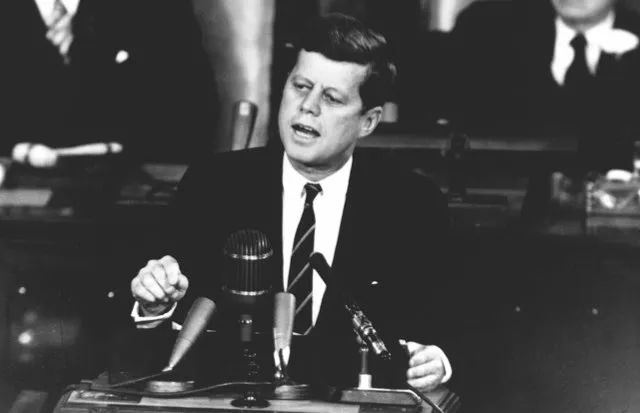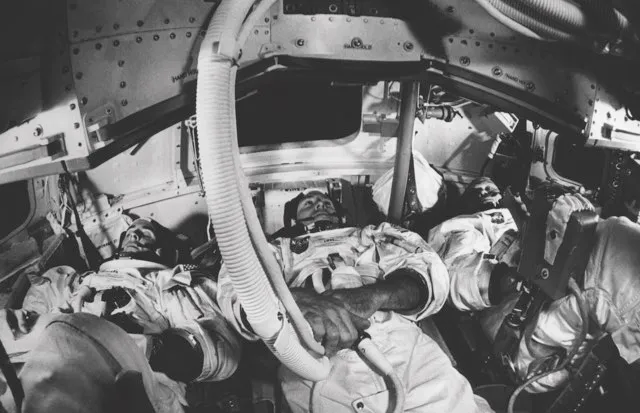Five decades after Neil Armstrong spoke the words, “Houston, Tranquility Base here. The Eagle has landed,” they still have the power to send shivers down your spine. With them, he told NASA’s mission control and an audience of almost 600 million people watching around the world that his lunar module had touched down on the surface of the Moon.
What happened on 20 July 1969, when Armstrong and Buzz Aldrin became the first men to walk on the grey, powdery surface of the Moon, was a landmark in human history – a “giant leap for mankind”, in Armstrong’s famous words. But, as Aldrin told television viewers the night before the astronauts returned to Earth, the Apollo 11 mission was also the reward for years of “blood, sweat and tears” from “thousands and thousands of people… who built the spacecraft; who did the construction, design, the tests, and put their hearts and all their abilities into those craft.”
Read more about the Apollo programme:
- 50 beautiful photos of the Moon landing missions from the Project Apollo Archives
- Nazis, magic and McCarthyism: the dark history of early American space exploration
It set the seal on years of hard work, inspired not only by technological curiosity and the human thirst for knowledge, but also by the ideological passions of the Cold War.
What is all too easy to forget about Apollo 11 is that it was the fifth manned spaceflight in NASA’s Apollo programme, and the third to travel to the Moon after Apollo 8 and 10, which had both orbited without landing. It was the climax of years of effort and dedication, in which NASA inched steadily closer to our celestial neighbour, driven by the fear that the Soviets would get there first.
The importance of being first to the Moon
The roots of the space race lay in two distinct sources: first, the extraordinary advances in rocketry made in the first half of the 20th century, often with German scientists at the forefront (notably the V2 designer Wernher von Braun, who went on to design the Apollo programme’s Saturn V rockets); and second, the political passions of the Cold War.
Since the late 1940s, the Western and Communist worlds had been locked in a bitter ideological, economic and military rivalry, a struggle not just of two great power blocs, American and Soviet, but of two systems that both claimed to represent the future of human society.
Victory in the space race – marked by the first satellite, the first astronaut, the first spacewalk or the first lunar landing – would mean a gigantic propaganda coup for the nation that could achieve it. And when first blood went to the Russians, after the Sputnik launch in 1957 and Yuri Gagarin’s space flight four years later, the pressure was on the Americans to follow suit.
Red star rising
When the Soviet Union launched Sputnik 1, the world’s first artificial satellite, in October 1957, the Cold War moved into space. Until the late 1950s, Western observers assumed that American technology was far ahead of its Soviet equivalent. But the Sputnik programme had become a matter of national pride for its Russian architects, a way of proving that their country had recovered from the war and that the Communist system would triumph over the capitalism of America.
In the United States, the reaction was fear and shock: congress rushed to pass the National Defense Education Act, redesigning the school curriculum and authorising $1 billion in extra spending to boost American science and technology.
Over the next few years, though, it was the Russians who led the way in an intensely competitive parallel to the arms race – the space race. In November 1957, Sputnik 2 made Laika the first dog in space, although she died just hours after take off. And in April 1961, Yuri Gagarin became the first man to orbit the Earth. He realised the dreams of generations who had stared up at the skies, and of the Soviet leadership, desperate for a propaganda coup.
As the 1960s progressed, however, NASA not only drew level but pulled ahead. With the Cold War at its height, victory in the space race had become a national priority. To American officials, Sputnik, Laika and Gagarin had been embarrassing defeats and they were determined to have the last laugh.
The powerhouse behind the American space programme was the National Aeronautics and Space Administration (NASA), created as a government agency in July 1958. Crucially, it was a civilian agency, not a military one, which made it easier to attract left-leaning scientists, but also meant occasional tensions with the Pentagon.
Its first major programme was Project Mercury, which ran from 1959 to 1963 and was designed to put the first American astronaut in orbit. Mercury reached fruition in February 1962, with Mercury-Atlas 6, which orbited the Earth three times and made its pilot, Marine Colonel John Glenn, a national icon.
By this time, however, the goal had changed dramatically. Gagarin’s space flight in April 1961 had deeply shaken morale in the White House, and a few days after it Vice President Lyndon Johnson reported to President John F Kennedy that, “…we are neither making maximum effort nor achieving the results necessary if this country is to reach a position of leadership” in the space race.
Picking up the pace
Since Kennedy was a committed Cold War warrior who had won office months earlier promising a new age of dynamic, aggressive leadership, he decided to act.
On 25 May 1961, addressing a joint session of Congress, he committed the administration to, “…achieving the goal, before this decade is out, of landing a man on the Moon and returning him safely to the Earth.” No other space project, he added, “will be more impressive to mankind, or more important in the long-range exploration of space; and none will be so difficult or expensive to accomplish.”

Kennedy’s pledge transformed the space race almost overnight. At the time of his speech, Glenn’s flight was still months away, and NASA seemed to be lagging behind its Soviet counterpart. Even some NASA employees, while delighted by Kennedy’s commitment, wondered whether his timetable was realistic.
But his rhetoric struck a chord in an affluent nation reared on tales of American exploration and the conquest of the frontier. And now, with a $25 billion funding commitment and 400,000 new jobs, the space programme had the chance to realise the President’s ambitions.
The first step was Glenn’s successful space flight. Next, the Mercury programme gave way to Project Gemini’s 10 manned flights in 1965 and 1966 and pioneered more advanced techniques such as in-flight radar, docking, rendezvous and an artificial horizon. All the time, NASA scientists were conscious of the pressure of Kennedy’s deadline, as well as of events outside the laboratory, such as the Vietnam War, which made American success in the space race all the more urgent.
1968: the us takes a chance
In 1968, NASA was still recovering from the previous year’s Apollo 1 tragedy, in which a fire ignited in the command module during a preflight test on the launchpad, killing the Apollo programme’s first crew: Gus Grissom, Ed White and Roger Chaffee.
Despite the disaster, the programme was still proceeding and the Apollo 7 mission saw a successful manned Earth orbital mission of the Apollo capsule in October 1968, proving that it was now ready for longer test flights.
The same could not be said of the full-scale Saturn V rocket, however. Unmanned tests revealed serious problems with its engines and control systems. Even so, NASA committed a human crew to the rocket’s next flight.
NASA administrator James Webb was under immense strain, trying to protect the programme’s reputation after the Apollo 1 disaster. When staff suggested flying a Saturn V, with a crew on board, all the way to the Moon, his initial response was: “Are you out of your mind? You’re putting our agency and the whole Apollo project at risk!” Then he looked at the latest intelligence reports from Russia and realised there was no choice but to get NASA astronauts to the Moon as fast as possible.
The Apollo 8 crew of Frank Borman, Bill Anders and Jim Lovell, made a circumlunar voyage during Christmas 1968, flying a relatively untested capsule on a full-scale Saturn V rocket that had spun out of control on its last test. The mission could easily have gone wrong. If it had, the Soviet Union might well have pushed on to make its secret Zond project a success.
Yet so big were the budgets, and such was NASA’s technical expertise, that progress was astonishingly swift. By October 1968, the first manned Apollo mission – an 11-day flight to test the new command module – was ready to take off. Three more missions were scheduled before July 1969. Month by month, America’s space pioneers were edging towards their goal.
Russian progress, meanwhile had been thrown into chaos by the death of Sergei Korolev, the Soviet Union’s chief rocket designer, in January 1966. With Korolev at the helm, the Soviet space programme had made great strides thanks to his unifying vision but in the absence of his leadership, rival schemes emerged for sending cosmonauts to the Moon. One team wanted to try for a landing, another believed a circumlunar flight without a landing was a more realistic goal.
In contrast, NASA in the 1960s was under the leadership of James Webb, a determined and focussed administrator who made sure that just one approach was chosen for America’s attempt on the Moon.
Listen to episodes of the Science Focus Podcastabout the moon landing:
- The mindset behind the Moon landing – Richard Wiseman
- Why is the Moon landing still relevant 50 years on? – Kevin Fong
Many people, including Saturn V mastermind Wernher von Braun, had different ideas about the mission, but Webb put his faith in Apollo’s spider-like lunar lander. He insisted that everyone within NASA had to support that design or leave.
Despite the Soviet programme being in disarray, there remained a reasonable chance that it could send an adapted Soyuz spacecraft around the Moon (although the capsule would have to be so laden with extra fuel and oxygen that only one cosmonaut could make the journey).
If Russia had managed this trip before Apollo’s first touchdown, the world may not have cared much about the distinction between a circumlunar trip and an actual landing. Russia would have scored another huge propaganda victory and we can only guess what the geopolitical consequences of such an achievement might have been.
The lead changes hands
On 18 September 1968, Russia succeeded in swinging the unmanned Zond 5 spacecraft around the Moon and back to Earth. The capsule splashed down in the Indian Ocean and was successfully recovered.
Two months later, NASA announced that its next flight, Apollo 8, would take off a few days before Christmas and head straight for the Moon, even though it would carry no lunar landing module. NASA was desperate to get men into the vicinity of the Moon as quickly as possible. The race was closer than many people realised at the time.

The Russian space programme was under just as much pressure as its American rival, who had experienced a number of disasters in its pursuit of progress, including the deaths of the Apollo 1 astronauts Gus Grissom, Ed White and Roger Chaffee in a launchpad fire. To retain their lead in the space race, the Russian engineers had been pushed by the Kremlin into using ever more dangerous versions of the R-7 rocket before rushing ahead with Korolev’s design for the N1 – the 30-engined launch vehicle intended to give the Soviets a Moon shot.
The N1 flew for the first time on 21 February 1969. It was in the air for just over a minute before spiralling out of control and exploding. It would be the longest flight the rocket ever recorded. A second test flight, on 3 July 1969, was even briefer with the rocket detonating shortly after lift-off and destroying the launch gantry.
Less than two weeks later, at 9.32am local time, on 16 July 1969, NASA’s Saturn V rocket launched Apollo 11 into the heavens from Kennedy Space Center, Florida. By this time, Kennedy himself was dead, having been assassinated six years earlier. Lyndon Johnson, who took office after Kennedy, had departed public life too, forced from the White House by the turbulent passions of the Vietnam War.
Their successor, the Republican Richard Nixon, watched the launch on his Oval Office television, along with millions of viewers around the world. The Space Race, the greatest adventure in our history and a stirring tribute to humanity’s energy and expertise, was underway.
Read more about Apollo with these features from BBC Sky At Night Magazine:
- In pictures: Apollo behind the scenes
- What have the Apollo 11 lunar samples taught us about the Moon?
- Where were you when Apollo 11 landed on the Moon?
Follow Science Focus onTwitter,Facebook, Instagramand Flipboard
